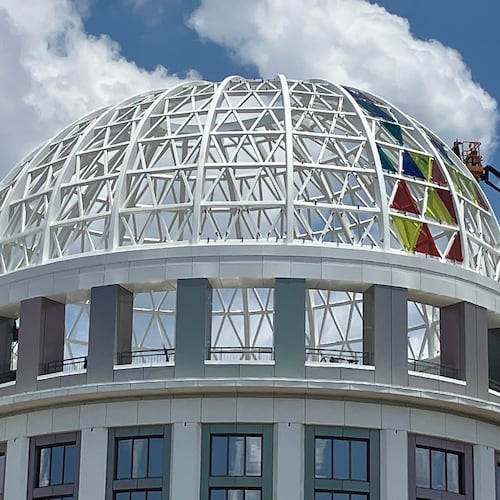If they build it, people will come in droves to Cobb County to see the Atlanta Braves play in a new stadium.
Those people will be using I-285, I-75, Cobb Parkway and other already congested roads to get to the Braves’ 81 home games.
I-75 through Cobb County is already one of the most congested corridors in the metro Atlanta region, with two universities, a Lockheed Martin aircraft plant, Cumberland Mall and Cobb Energy Performing Arts Centre among the big draws. Even before the new stadium was announced, the average daily traffic volume in the corridor was expected to grow from 298,000 to 301,000 over the next two decades.
So how is the stadium going to impact all those drivers?
Apparently nobody has even considered that yet. The state agency that does transportation planning hasn’t studied the issue. Officials at the Georgia Department of Transportation, as well as the Atlanta Regional Commission and MARTA, said they were caught off-guard by the relocation announcement Monday.
“This announcement is an unexpected development, and we are still in the process of gathering information,” said Lyle Harris, a spokesman for MARTA. “We’re going to take a wait-and-see approach.”
Natalie Dale, a spokeswoman for GDOT, said the Braves have not availed themselves of the state’s traffic studies in selecting a site.
“We will work with the Braves organization and Cobb County to see that the proper regional traffic impact studies are completed,” Dale said.
Braves management cited a lack of consistent mass transit to the facility, lack of adequate parking and lack of access to major roadways as primary reasons for abandoning Turner Field.
MARTA rail service doesn’t reach Turner Field, but it also doesn’t reach Cobb.
A map of 2012 Braves ticket purchasers shows the highest concentration of fans live in the northern Atlanta suburbs. Many of them would presumably have an easier time driving to a ballpark stationed along the Perimeter than one downtown.
Fans in the southern metropolitan region will have it even harder than now.
Richard Oden chairs an ARC committee that would consider the development’s impact. He also chairs the Rockdale County commission. Oden said for people in his county on the eastern side of Atlanta, “This means they’ve got to drive farther to go to the ball game.”
“As opposed to going down I-20 to 75,” he said, “they’ve got to go all the way up to Cobb on much more congested interstates.”
Voters in Cobb County have repeatedly rejected a MARTA rail expansion.
There is existing bus service to the Cumberland Mall area. Cobb County Transit’s most popular route (Route 10) connects people from the Arts Center Station in Midtown to Cumberland Mall.
Cobb DOT Director Faye DiMassimo said the county would seek additional funding to add more buses to that route, as well as shuttles that can transport people from parking lots to the stadium.
The county also is studying a $1.1 billion, bus rapid transit system that would ferry people from Kennesaw to Atlanta on a dedicated lane that is separated from normal traffic to avoid congestion.
However, Cobb will be competing against other local governments nationwide for the Federal Transit Administration dollars to fund those projects.
Tad Leithead (who heads the Cumberland Community Improvement District and chairs the Atlanta Regional Commission) said getting a bus-rapid transit system in place before opening season would be a long shot. Usually it takes decades to get one in place because of federal environmental hurdles and right-of-way acquisition.
Nevertheless, “I would hope this would put more impetus behind transit for Cobb,” Leithead said, adding that about 55 percent of Cobb commuters say they support it.
State transportation planners are studying potential improvements to the northern end of I-285, to include the possibility of adding a commuter lane or optional toll lanes there. However, it’s “all conceptual” at this point, Dale said, and there’s also no funding for it.
I-75 improvements are imminent. Two reversible toll lanes along the west side of I-75 from the Perimeter to I-575 are expected to open by spring 2018.
However, current plans call for the reversible toll lanes to be directed northward — away from the city and stadium during evening rush hour and on weekends when drivers are traveling to games.
The Cumberland CID self-taxing business district has made great strides in improving local traffic, said Dan Reuter, the Atlanta Regional Commission’s community development manager.
“They’ve built tremendous infrastructure over the last decade,” Reuter said. “There’s a lot of capacity there to handle traffic, maybe not at that site specifically, but in the area.”
Before Opening Day 2017, a diverging diamond interchange will be open on Windy Hill Road and I-75. Cobb Parkway also will be widened along a one -mile stretch between Paces Mill and Akers Mill roads from five to six lanes.
Staff writer Ariel Hart contributed to this story.
About the Author
Keep Reading
The Latest
Featured


